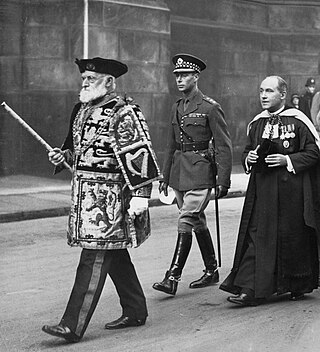
The Right Honourable the Lord Lyon King of Arms, the head of Lyon Court, is the most junior of the Great Officers of State in Scotland and is the Scottish official with responsibility for regulating heraldry in that country, issuing new grants of arms, and serving as the judge of the Court of the Lord Lyon, the oldest heraldic court in the world that is still in daily operation.

An officer of arms is a person appointed by a sovereign or state with authority to perform one or more of the following functions:

In Scotland, "baron" or "baroness" is a rank of the ancient nobility of the Baronage of Scotland, and a title of honour, and refers to the holder of a barony, formerly a feudal superiority or prescriptive barony attached to land erected into a free barony by Crown Charter, this being the status of a minor baron, recognised by the crown as noble, but not a peer.

The Canadian Heraldic Authority is part of the Canadian honours system under the Canadian monarch, whose authority is exercised by the Governor General of Canada. The authority is responsible for the creation and granting of new coats of arms, flags, and badges for Canadian citizens, government agencies, municipal, civic and other corporate bodies. The authority also registers existing armorial bearings granted by other recognized heraldic authorities, approves military badges, flags, and other insignia of the Canadian Forces, and provides information on heraldic practices. It is well known for its innovative designs, many incorporating First Nations symbolism.

The Royal Banner of the Royal Arms of Scotland, also known as the Royal Banner of Scotland, or more commonly the Lion Rampant of Scotland, and historically as the Royal Standard of Scotland, or Banner of the King of Scots, is the royal banner of Scotland, and historically, the royal standard of the Kingdom of Scotland. Used historically by the Scottish monarchs, the banner differs from Scotland's national flag, the Saltire, in that its official use is restricted by an Act of the Parliament of Scotland to only a few Great Officers of State who officially represent the Monarchy in Scotland. It is also used in an official capacity at royal residences in Scotland when the Head of State is not present.

Sir Thomas Innes of Learney (1893–1971) was a Scottish officer of arms who was Lord Lyon from 1945 to 1969.

Rothesay Herald of Arms in Ordinary is a current Scottish herald of arms in Ordinary of the Court of the Lord Lyon.

Ross Herald of Arms Extraordinary is a Scottish herald of arms Extraordinary of the Court of the Lord Lyon. The office is however held in Extraordinary after the retirement of the last holder in Ordinary.

Heraldry in Scotland, while broadly similar to that practised in England and elsewhere in western Europe, has its own distinctive features. Its heraldic executive is separate from that of the rest of the United Kingdom.
Elizabeth Ann Roads, is a former Scottish herald, an office from which she retired in 2021; in July 2018 she retired as Lyon Clerk at the Court of the Lord Lyon
The Public Register of All Arms and Bearings in Scotland, established in 1672, is an official register of Scottish coats of arms maintained by the Lyon Clerk and Keeper of the Records. As a public register, it can be seen by anyone on application, and on payment of a statutory fee.

Snawdoun Herald of Arms in Ordinary is a current Scottish herald of arms in Ordinary of the Court of the Lord Lyon.

Marchmont Herald of Arms is a current Scottish herald of arms of the Court of the Lord Lyon

Sir Francis James Grant (1863–1953) was a Scottish officer of arms who eventually rose to the office of Lord Lyon King of Arms. Grant served in the Court of the Lord Lyon as Carrick Pursuivant of Arms in Ordinary beginning on 17 May 1886. This appointment lasted until his promotion to the office of Rothesay Herald of Arms in Ordinary and Lyon Clerk and Keeper of the Records on 8 September 1898.
John Inglis Drever "Don" Pottinger (1919–1986) was a Scottish officer of arms, artist, illustrator and author. He is remembered for the publication, with Sir Iain Moncreiffe, of Simple Heraldry, Cheerfully Illustrated (1953).

The coat of arms of the City of Edinburgh Council is the coat of arms belonging to The City of Edinburgh Council, the local authority of Edinburgh, Scotland. The coat of arms was registered with the Lord Lyon King of Arms in 1732, having been used unofficially for several centuries previously. The central symbol is a castle, representing Edinburgh Castle.

The Court of the Lord Lyon, or Lyon Court, is a standing court of law, based in New Register House in Edinburgh, which regulates heraldry in Scotland. The Lyon Court maintains the register of grants of arms, known as the Public Register of All Arms and Bearings in Scotland, as well as records of genealogies.

Sir Alexander Erskine of Cambo, 2nd Baronet of Cambo, Fife was a Scottish baronet and Lord Lyon, King of Arms.

Souvenir plots of land were first defined in section 4(1)(b) of the Land Registration (Scotland) Act 1979 as

The Armorial Register Limited is a British publishing company focused on heraldic and genealogical topics. It was founded in 2006 with the aim of producing works related to heraldry and associated fields of study.






























